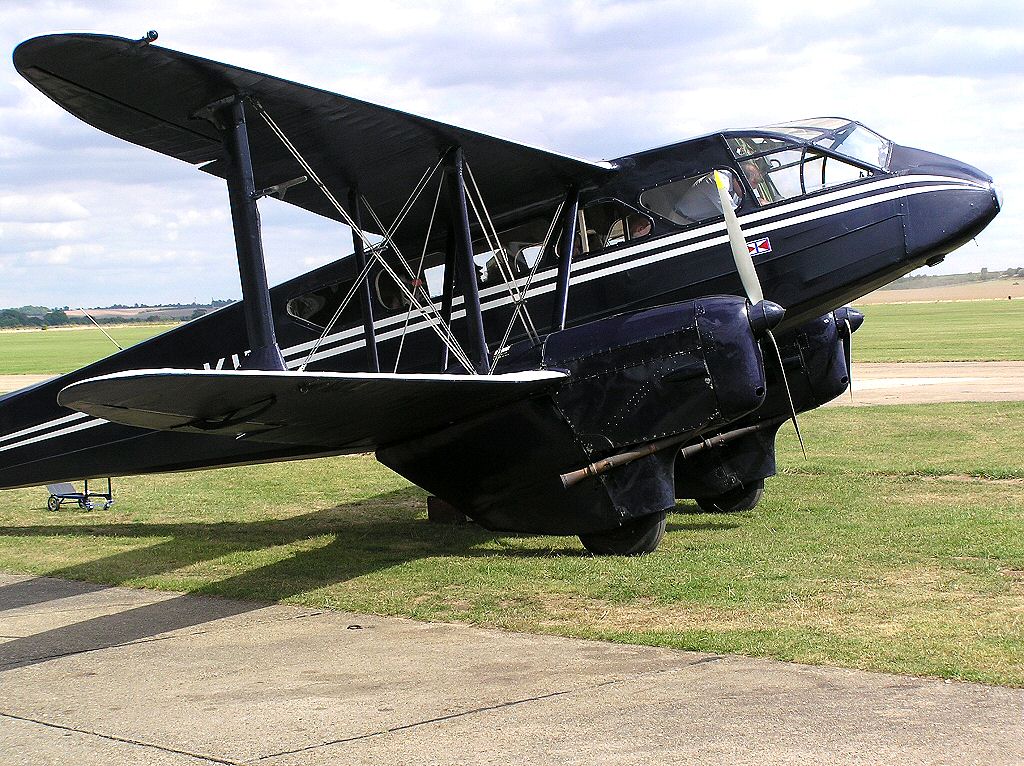|
The prototype first flew on 17 April 1934 and 205 were built for owners all around the world before the outbreak of World War II. Originally designated the "Dragon Six" it was first marketed as "Dragon Rapide" although was later just called a "Rapide". With the fitting of improved trailing edge flaps from 1936, they were redesignated DH.89As.
After the initial trials had taken place at Martlesham Heath, the Rapide was very quickly cleared for service and the prototype was sold to Ostschweiz AG for services between St Gaul, Zurich and Berne. Another early Rapide was entered for the 1934 England to Australia air race and despite some adventures it eventually finished in a respectable 5th in the speed section of the race.
The type entered service with UK-based airlines in the summer of 1934 with Hillman Airways Ltd being first to take delivery in July. Railway Air Services (RAS) operated a fleet of Rapides from August 1934 on routes linking London, the north of England and on to Northern Ireland and Scotland. The RAS DH.89s were named after cities on the network and (eg) "Star of Lancashire
One famous incident involving the use of a DH.89 was in July 1936 when two British MI6 intelligence agents, Cecil Bebb and Major Hugh Pollard, flew Francisco Franco in one from the Canary Islands to Spanish Morocco, at the start of the military rebellion which began the Spanish Civil War
At the start of World War II many (Dragon) Rapides were impressed by the British Royal Air force. During the war strategic materials such as aluminium became harder to come by, the Rapides old design with it’s wood and fabric structure more aircraft were ordered and served under the name de Havilland Dominie. There were two versions. The Mark 1 was a wireless and navigation trainer and the Mark 2 was the light transport and communications version. Over 500 were built specifically for military purposes, powered by improved Gipsy Queen engines, to bring total production to 731. Operations were not restricted to the United Kingdom and Rapides were to be found all over the World in the service of Air Forces of the former Empire.
Many survivors entered commercial service after the war and were made available to charter companies and “start-up” airlines after a conversion which basically involved new paint, soundproofing and better seats. Eighty one were still flying on the British register in 1958. British European Airways, merged with BOAC to form the present day British Airways. They had a fleet of Rapides for the short distance over-water routes in Scotland, Scilly and Channel Islands. Dominie production was by both de Havilland and Brush Coachworks Ltd, the latter making the greater proportion.
The DH.89 proved a very durable aircraft despite its relatively primitive plywood construction and many were still flying in the early 2000s. The types’ continuing versatility led to it being used worldwide for tasks such as aerial survey, oil exploration, ambulance flights, parachute dropping and to bring the wheel full circle, pleasure flying. Several Rapides are still operational in the UK and several suppliers still offer pleasure flights in them. A Rapide can be seen in the Museum of Science and Industry in Manchester. Two Rapides are still airworthy in New Zealand. There is a Dragon Rapide flying with the Military Aviation Museum in Virginia Beach, Virginia, and another one based in Yolo County, California. Two are operated by classic wings for pleasure flights in UK normally based in Duxford.
These aircraft photographs are great reference sources if your painting 1/72 scale, 1/48 scale or 1/24 scale plastic model airplane Airfix, Tamiya, zvezda, revel, Pavala aircraft kits or you’re into flying and painting radio RC controlled model planes.
There are many aviation books published about DH.89 de Havilland Dragon Rapide
www.MooreAircraft.com
Tell your friends about us. Send them an e-mail
|
